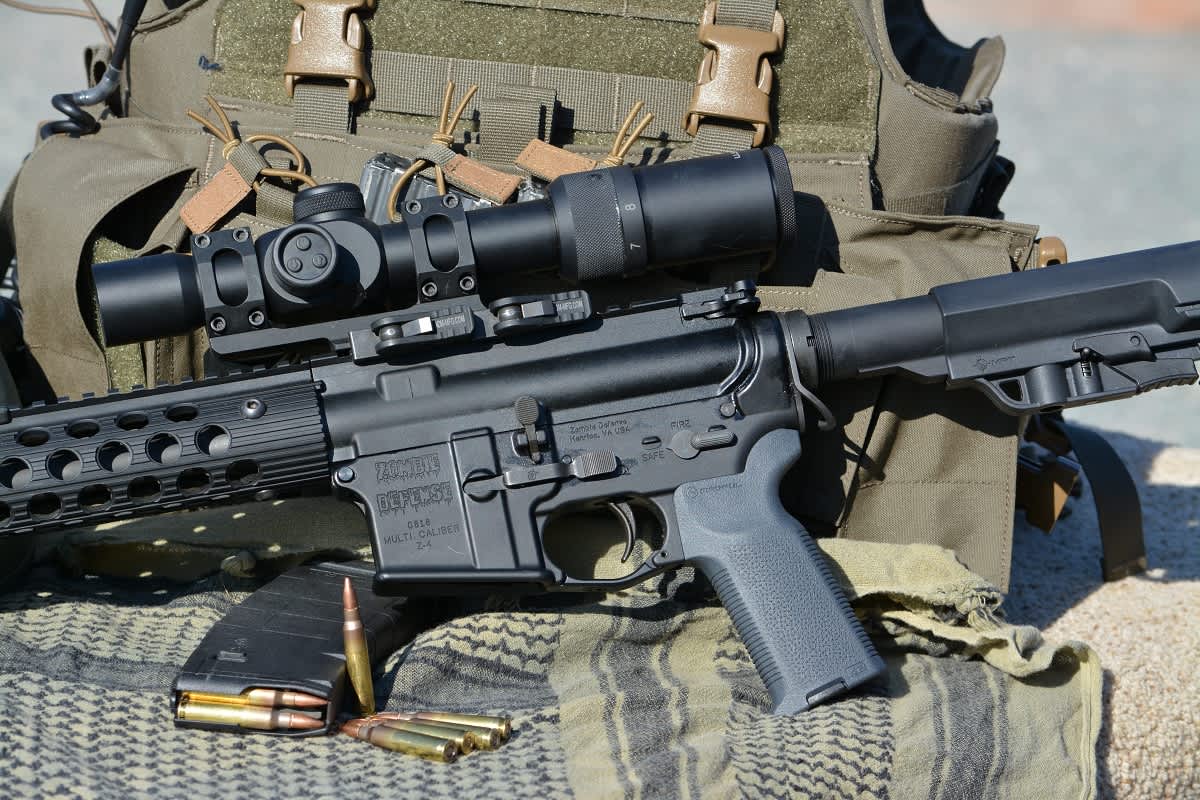Bridging the Gap: The U.S. Optics SR-8C Scope
Harry Fitzpatrick 05.04.15

When choosing an optic, the most important question that needs to be asked is what purpose the optic will serve. In the past, shooters have been limited to choosing an optic that is driven towards a specific mission. An operator might have a simple red dot sight system on an M4 for making entries. On the other hand, a sniper might have a 5-25x optic for engaging targets at great distances. U.S. Optics has broadened the spectrum so that one optic can fulfill multiple roles.
The SR-8C by U.S. Optics is one such optic that fulfills multiple functions. The illuminated red dot allows for up-close precision shooting. While the 1-8x adjustable magnification gives the shooter the ability to engage a target at varying distances. The other important aspect to note about this scope is its ruggedness.
The first thought that popped into my brain when I held this scope is “sturdy.” There is no other way to describe it but as one robust piece of hardware. It is obvious that this scope was engineered to take a beating. Everything from the body of the scope, recessed lenses, to the turrets appears to be engineered specifically to be ultra-durable.
I have to admit that when I first mounted this optic on my personal AR-15, it felt different. I’m used to an EOTech on my work AR because I prefer to run my rifle as slick as possible. When I mounted the SR-8C on my gun, it felt a little heavy but that was not an issue—other than the fact that it simply felt “different.”
After getting it mounted to the AR, I had to turn on the red dot and practice snapping the rifle in on different targets in the house. Regardless of what magnification it was set on, the bright red dot appeared on the target. The one thing I noticed was that there was scope shadow. By keeping my non-dominant eye open, the red dot was superimposed on the target, even when it was black from scope shadow. This would take a little time to get used to and needed extra reps to get proficient in using this optic at CQB distances. As with any aspect of firearm discipline, constant and quality practice equals proficiency.
Putting the scope to the test at the range proved to be quite an eye-opener. I began by zeroing the scope at 100 yards. Keep in mind the rifle that I was using was a “budget” AR-15 build. It sports a Spikes Tactical 16-inch barrel,and an Aero Precision upper receiver. There’s nothing special about the rifle, yet with the SR-8C I was consistently getting .5-inch to one-inch groups at 100 yards. The ammo I was using was American Eagle 62-grain. The SR-8C allowed me to shoot my budget rifle to its full potential!
While shooting at 100 yards, there were several aspects to the scope that really stood out. To begin with, the exceptional clarity of the glass made the target crisp and detailed. The thickness of the crosshair when zoomed in at eight power made for faster first shots and subsequent follow-up shots. The only drawback for the thicker crosshair was that the crosshairs almost covered the bull’s-eye on the target. However, this scope is not meant to be a benchrest scope with a fine crosshair. Hitting a six inch bull at a 100 yards standing and unsupported was quite an easy feat with the SR-8C.
After confirmation of zero at 100 yards, it was time to move on to the 500-yard range. At this point I had run out of 62-grain and had to switch over to 55-grain Federal. I was a little concerned that it was going to make a difference at the greater distances, but in the end it didn’t. Before I even loaded the AR, I wanted to look through the optic and see what the 500-yard steel looked like. I couldn’t believe how clear and easy it was to pick up the steel plate. I told my friend, who was helping me out, to look through the optic. His immediate reaction was, “Man, that’s like cheating.”
On the 500-yard range, we had steel targets set up at 200, 300, 400, and, of course, 500 yards. I started off with the 200-yard plate. I had to hold the crosshair toward the top of the steel and was hitting it with ease. It was almost too easy, and I moved on to the steel at the 300. I had to move to the next stadia line, and ringing it at 300 was effortless.
The 400- and 500-yard line proved to be a small hurdle to get over but in the end it was easy. At both the 400 and 500, it took a little time to figure out which stadia line to use. Once I figured that out, the bullets were smacking the steel at both distances.
My friend brought up a good point about making adjustments between the varying distances. He came up with the idea of setting up the card that matches the reticle of the scope, and marking distances on the card at each respective stadia line. This would make for quick reference and would be faster than making adjustments. Making a windage or elevation adjustment on this scope is slow compared to using hold-overs. The adjustment knobs are covered by screw-on caps. These caps need to be on because the knobs do not lock into place after adjustment.
This scope proved to be a well-made, multi-faceted piece of equipment. Up close or at distance, the SR-8C bridges the gap between red dots and high-magnification scopes. In the hands of a SWAT officer on a perimeter of a hostage situation or in capable hands of a designated marksman on patrol, this scope would prove to be a great asset. It retails for $2,495.

